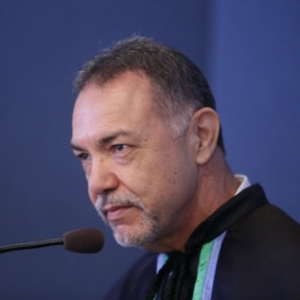Maria Cristina Gamberini, University of Modena e Reggio Emilia, Italy
The solid-state characterization of pharmaceutical compounds plays a pivotal role in understanding and controlling the physical and chemical properties of active pharmaceutical ingredients (APIs) and excipients. This work presents an integrated overview of analytical techniques a [....] » Read More



















































Title : Ectopically expressed olfactory receptors as an untapped family of drug targets and discovery of agonists and antagonists of OR51E1, an understudied G protein-coupled receptor
Vladlen Slepak, University of Miami Miller School of Medicine, United States
Over 30% of pharmaceuticals act on G protein-coupled receptors (GPCRs), the largest family of human genes (~800). About 50% of GPCRs (~400) are Olfactory receptors (ORs); these GPCRs were originally discovered in the nasal epithelium, where they mediate the sense of smell. [....] » Read More
Title : Innovative development and delivery of biologics for chronic obstructive pulmonary disease
Yong Xiao Wang, Albany Medical College, United States
It is well known that chronic obstructive pulmonary disease (COPD) is a common and devastating lung disease with a high mortality. The current therapeutics for this disease are neither specific nor very effective. Moreover, the pathogenesis mechanisms for this disease remain larg [....] » Read More
Title : Personalized and Precision Medicine (PPM) as a unique healthcare model through de-sign-inspired biotech- & biopharma-driven applications and upgraded business mar-keting to secure the human healthcare and biosafety
Sergey Suchkov, N.D. Zelinskii Institute for Organic Chemistry of the Russian Academy of Sciences & InMedStar, Russian Federation
Traditionally, a disease has been defined by its clinical presentation and observable characteristics, not by the underlying molecular mechanisms, pathways and systems biology-related processes specific to a particular patient (ignoring persons-at-risk). A new systems approach to [....] » Read More
Title : Macitentan/tadalafil combination– An additional value in pharmacotherapy of pulmonary arterial hypertension
Miroslav Radenkovic, University of Belgrade, Serbia
Pulmonary arterial hypertension (PAH) remains a devastating disease with high morbidity and mortality. It is uncommon, progressive and life-threatening blood vessel disorder differentiated by the constriction of minor pulmonary arteries and elevated blood pressure in the pulmonar [....] » Read More
Title : Identification of sulfonamide-based aromatase inhibitors in the breast cancer research
Barbara De Filippis, University of Chieti, Italy
Breast cancer (BC) represents the type of cancer that most frequently affects women and one of the leading causes of death among females worldwide. Approximately 70% of cases of BC are estrogen dependent (Hormone Receptor-Positive, HR+), since high levels of these hormones are ne [....] » Read More
Title : Pharmacology of chlorphenamine and pseudoephedrine use in the common cold
Rassa Pegahi, UPSA, France
The common cold is the most frequent upper respiratory viral infection. Although benign, it represents a high socioeconomic burden. Many over-the-counter drugs are available to manage the symptoms of this condition, with antihistamines and vasoconstrictors being the most widely u [....] » Read More
Title : Antibody-proteases as translational tools of the next-step generation to be applied for biopharmacy-related and precision medical practice
Sergey Suchkov, N.D. Zelinskii Institute for Organic Chemistry of the Russian Academy of Sciences & InMedStar, Russian Federation
High impact of Ab-proteases is valuable to monitor both clinical and subclinical courses of chronic autoimmune inflammation to predict stepwise transformations of the course, starting from the pre-illness and to prognosticate the clinical illness finally. This information would a [....] » Read More
Title : Is paracetamol (acetaminophen) still a first line option for pain and fever in paediatrics?
Rassa Pegahi, UPSA, France
Background and Aim: Effective analgesia and fever management in children from birth remain crucial. This study aims to provide updated insights into the use of paracetamol in pediatric care. Methods: A comprehensive bibliographic search was conducted, focusing on clinical stud [....] » Read More
Title : Innovations in rivastigmine delivery: Nanostructured lipid carriers encapsulated in microneedles for enhanced transdermal delivery
Shereen M Assaf, Jordan University of Science and Technology, Jordan
Rivastigmine (RHT), used in the management of Alzheimer's disease, reduces acetylcholine degradation and enhances the cognitive function. Challenges in RHT delivery arise due to its limited ability to permeate the brain, short half-life, low bioavailability, and abdominal sid [....] » Read More
Title : Assessment of inulin content in Arctium Lappa l. root extract: Potential for nutritional and medicinal applications
Elena Donici, State University of Medicine and Pharmacy, Moldova, Republic of
Inulin, scientifically known as α-D-glucopyranosyl-β-D-fructofuranosyl-D-fructofuranoside, is a natural polysaccharide with diverse biological activities. It is widely used in the food and pharmaceutical industries as a soluble dietary fiber, sugar substitute, stabiliz [....] » Read More
Title : Evaluating Aronia Melanocarpa varieties for pharmaceutical applications based on polyphenolic content and antioxidant activity
Iulia Bozbei, State University of Medicine and Pharmacy, Moldova, Republic of
In recent years, the global community has been actively seeking plant-based sources with therapeutic and nutritional potential. The fruits of Aronia melanocarpa are widely recognized and utilized for these purposes. The challenges caused by global warming and changing climatic co [....] » Read More
Title : Therapeutic efficacy of nanostructured lipid carriers co-loaded with simvastatin and adenosine (NLC- SA) in a human epidermal model of diabetic chronic wound
Regina Gomes Dare, University of São Paulo, Brazil
Chronic wounds are characterized by persistent inflammation, elevated oxidative stress, and impaired tissue repair, posing a major clinical challenge, particularly in diabetic patients. In this study, we established a reconstructed human epidermis (RhE) model using primary neon [....] » Read More
Title : Advances in hydrophilic drug delivery: Encapsulation of biotin in alginate microparticles
Iria Naveira Souto, Reig Jofre | University of Barcelona, Spain
The encapsulation of hydrophilic drugs within microparticles has gained significant interest in drug delivery systems due to their potential to improve the stability, bioavailability, and controlled release of therapeutic agents. Biotin, a water-soluble vitamin, faces challenges [....] » Read More
Title : Formulation and characterization of buccal films based on sodium alginate and chitosan for using in parkinson's disease
Krisztian Pamlenyi, University of Szeged, Hungary
Parkinson's disease is the second most common neurodegenerative disease in the world, 16-20 thousand people suffer from this disease in Hungary and more than 10 million people worldwide. The symptoms can be various, both non-motor and motor symptoms can appear. The biggest pr [....] » Read More
Title : The promise of nanotechnology in personalized & precision medicine: Drug discovery & development being partnered with nanotechnologies via the revolution at the nanoscale
Sergey Suchkov, N.D. Zelinskii Institute for Organic Chemistry of the Russian Academy of Sciences & InMedStar, Russian Federation
A new systems approach to subclinical, predictive and/or diseased states and wellness resulted in a new Hi Tech trend in the healthcare services, namely, personalized and precision medicine (PPM). Meanwhile, despite breakthroughs in designed-driven research that have led to an in [....] » Read More
Title : GastroPlus® and ADMET Predictor driven predictive model for pharmacokinetic parameters of ENDOL® immediate-release capsule
Ayse Nur Oktay, University of Health Sciences-Gulhane Faculty of Pharmacy, Turkey
In silico tools have become indispensable for preclinical assessment of pharmacokinetic parameters of drug. Several commercial software platforms, such as GastroPlus®, PK-Sim®, Stella®, and GISim®, offer comprehensive simulation capabilities for drug absorption, [....] » Read More
Title : Design and computational analysis of a peptide analogue with a WXXW motif: A membrane-active and reversible drug binding peptide to overcome cancer drug resistance
Nurul Ain binti Mohammad Hamdi, University of Manchester, United Kingdom
Membrane-active peptides are known for their ability to transport therapeutic agents across cellular membranes, thereby enhancing intracellular delivery. In this study, we designed a membrane-active peptide analogue by incorporating a drug-binding sequence. This modification aims [....] » Read More
Title : Enhancing delivery of biopharmaceutics classification system class ii drugs through a novel carrageenan-alginate-oleogel matrix: A case study on praziquantel for improved therapeutic efficacy
Consolata Nsanzubuhoro, Stellenbosch University, South Africa
Schistosomiasis, a waterborne neglected tropical disease (NTD) prevalent in sub-Saharan Africa and South-East Asia significantly impacts socio-economic development. Praziquantel (PZQ) serves as the primary treatment, effective against all human schistosome species. However, PZQ&# [....] » Read More
Title : What Caffein brings to Paracetamol (Acetaminophen) in pain Management
Rassa Pegahi, UPSA, France
Background: Paracetamol is effective and safe in mild to moderate migraine attacks and episodes of tension-type headache (TTH). Few data are available on the use of paracetamol combined with caffeine, the aim of which is to achieve a higher analgesic efficacy of paracetamol [....] » Read More
Title : Enabling Active Pharmaceutical Ingredient Industry in Saudi Arabia
Waleed Mohammed Al Shaqha, Imam Muhammed Ibn, Saudi Arabia
The local production of active pharmaceutical ingredients (APIs) plays a vital role in strengthening national healthcare resilience by improving access to essential medicines and reducing dependence on imports and global supply chains. While the API industry is heavily driven by [....] » Read More
Title : Intelligent delivery of 5-fluorouracil using smart polymers
Mutaz S Salem, Jordan University of Science and Technology, Jordan
Colonic drug delivery systems have been utilized to treat a wide range of bowel illnesses, including colorectal cancer, ulcerative colitis, diverticulitis, Crohn's disease, and IBS. These systems can improve therapeutic efficacy by limiting undesired absorption in other parts [....] » Read More
Title : Astrotactin 2 as novel analgesic target candidate for cancer pain and opioid sparing: An exploratory genetic polymorphism analysis
Mizuho Sumitani, The University of Tokyo Hospital, Japan
Introduction: Cancer pain impairs not only physical functions but also social functions and roles. Neuronal protein astrotactin 2 (ASTN2) fulfills a function to regulate the release of neuronal adhesions to the glial fiber. Genetic variability in the ASTN2 gene was reportedly ass [....] » Read More
Title : Evaluating maleic anhydride derivatives as linkers for Ph-sensitive drug release
Mateusz Mlynek, NanoSanguis S.A., Poland
Cancer remains a persistent global health challenge. Current therapeutic strategies often fall short due to the adaptive nature of tumor cells, highlighting the urgent need for innovative drug delivery approaches. Recent advances emphasize improved drug selectivity through platfo [....] » Read More
Title : Evaluating maleic anhydride derivatives as linkers for Ph-sensitive drug release
Weronika Leszczynska , NanoSanguis S.A., Poland
Cancer remains a persistent global health challenge. Current therapeutic strategies often fall short due to the adaptive nature of tumor cells, highlighting the urgent need for innovative drug delivery approaches. Recent advances emphasize improved drug selectivity through platfo [....] » Read More
Title : Evaluating Maleic Anhydride Derivatives as Linkers for Ph-Sensitive Drug Release
Julia Macyszyn, NanoSanguis S.A., Poland
Cancer remains a persistent global health challenge. Current therapeutic strategies often fall short due to the adaptive nature of tumor cells, highlighting the urgent need for innovative drug delivery approaches. Recent advances emphasize improved drug selectivity through platfo [....] » Read More
Title : Liposomal formulation and quantitative HPLC analysis of random peptide mixtures for antibacterial drug development
Michal Szkop, NanoSanguis S.A., Poland
The rising antibiotic resistance among bacterial pathogens presents a growing global health concern, necessitating the exploration of novel therapeutic approaches. One promising alternative to traditional antibiotics is the use of peptides. Random peptide mixtures (RPMs), charact [....] » Read More
Title : Liposomal formulation and quantitative HPLC analysis of random peptide mixtures for antibacterial drug development
Marzena Kaliszewska Kozak , NanoSanguis S.A., Poland
The rising antibiotic resistance among bacterial pathogens presents a growing global health concern, necessitating the exploration of novel therapeutic approaches. One promising alternative to traditional antibiotics is the use of peptides. Random peptide mixtures (RPMs), charact [....] » Read More
Title : The Physicochemical, biopharmaceutical, and in vitro efficacy properties of diclofenac-loaded liposomes
Iria Naveira Souto, Reig Jofre | University of Barcelona, Spain
Diclofenac-loaded liposomes were developed as a tool to treat inflammatory skin disorders. Topical administration of this molecule is a challenge that can be addressed by encapsulation into drug delivery systems. The aim of the current study was to develop, purify and optimize th [....] » Read More